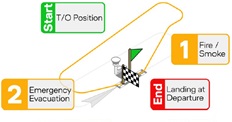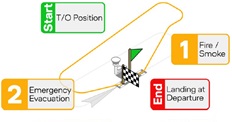Competency development in practice
The goal of the CBTA is to ensure that the training is tailored to the needs of the pilot as an individual, the pilot population (e.g., pilot fleet needs) and the organization (e.g., airline). The training designer should ensure that the curriculum permits to achieve this goal by integrating the scenarios that are relevant and realistic to the operator and the fleet level.
Concerning the competency development at the individual pilot level, the training designer should use the following options for the CBTA consolidation session:
1. The content of the session is totally prescriptive, but the instructor can choose different routes within the session in order to develop different competencies. Each route places special emphasis on specific pilot competencies.
Example
CBTA consolidation session content |
All pilot competencies are trained and assessed |
The instructor selects the route according to the pilot performance demonstrated during the CBTA refresher session
|
Route 1: Special emphasis SAW and LTW


|
Route 2: Special emphasis COM and WLM


|
2. The content of the session is partially prescriptive and there is dedicated spare time within the session that allows the instructor to develop the pilot's competencies with the instructor "toolbox". The instructor selects the exercises that place special emphasis on specific pilot competencies.
Illustration
CBTA consolidation session content |
All pilot competencies are trained and assessed |
Spare time within the session
The organization provides the instructor with a set of events-exercises that permits to place special emphasis on the competencies that have been identified as "to be enhanced" (or consolidated) during the CBTA refresher session
The so called "instructor toolbox" is organized by family of events-exercises and by competencies. Refer to Annex 3 for an instructor toolbox example.

Description
|
Timing
|
KNO
|
PRO
|
COM
|
FPA
|
FPM
|
LTW
|
PSD
|
SAW
|
WLM |
Management of the priorities
|
| | | |
|
|
|
| |
*
|
Uncontained engine fire
|
10
| | | |
| | | | | |
Smoke
|
10 | |
*
| | | |
*
|
*
|
*
|
* |
Pilot incapacitation during take-off roll
|
5
| | | | | | |
*
| |
*
|
|
Evidence-based training (EBT) principles
The aim of EBT is to identify, develop and evaluate the competencies required to operate safely, effectively and efficiently in a commercial air transport environment whilst addressing the most relevant threats according to evidence collected in accidents, incidents, flight operations and training.
During COVID operations, the IATA Safety Department has identified a significant increase of events related to unstable approaches due to the pilot mismanagement of the energy, and unreliable airspeed indications due to the contamination of pitot/static systems on aircraft returned to service after a period of storage.
Therefore, this simulator refresher session should use scenarios that integrate the management of the above-mentioned events as "vehicles" to develop the pilot competencies.
Example of Scenario elements challenging the pilot ability to manage the energy of the airplane:
-
Scenario element 1: ATC or terrain related environment creating a high energy descent with the need to capture the optimum profile to complete the approach in a stabilized configuration
-
Scenario element 2: ATC or terrain related environment creating a high energy descent leading to unstable conditions and requiring a go-around
Table 1: Competency map for the descent and approach scenario
Pilot Competencies |
Scenario element 1 |
Scenario element 2 |
Application of Knowledge |
X |
X |
Application of Procedures and
Compliance with Regulations |
X |
X |
Communication | | |
Aeroplane Flight Path Management, automation |
X |
X |
Aeroplane Flight Path Management, manual control | | |
Leadership and Teamwork | | |
Problem Solving and Decision Making |
| |
Situation Awareness and Management of Information |
X |
X |
Workload Management | | |
Further details about scenario elements concerning the unstable approach can be found in ICAO Doc 9995 Manual of Evidence-based Training.
Example of scenario elements challenging the pilot's ability to manage unreliable airspeed indication:
-
Scenario element 1: During a very short positioning flight without passengers on board, repetitive and intermittent Air Data Reference Unit 2 fault [identical to pitot probe #2 blocked by insects]. Keep malfunction steady when already in approach.
-
Scenario element 2: During cruise, Air Data Reference Unit 2 fault [due to blocked pitot #2] and Air Data Reference Unit disagreement leading to the degradation of flight control laws.
-
Scenario element 3: During take-off run introduce airspeed discrepancy between Air Data Reference Unit 1 and Air Data Reference Unit 2 before 100kt.
Table 2: Competency map for the unreliable airspeed scenario
|
Pilot Competencies |
Scenario element 1 |
Scenario element 2 |
Scenario element 3 |
Application of knowledge |
X |
X | |
Application of procedures and
compliance with regulations |
X |
X |
X |
Communication | | | |
Aeroplane Flight Path Management, automation | | | |
Aeroplane Flight Path Management, manual control | |
X | |
Leadership and Teamwork | | | |
Problem Solving and Decision Making |
X |
X |
X |
Situation awareness and management of information | |
|
X |
Workload Management |
X |
X | |
Link to
the IATA Safety and Flight Ops Operational notices, Unstable approach during reduced operations:
Link to
the IATA Safety and Flight Ops Operational notices, Contamination of pitot/static systems on aircraft returned to service after a period of storage.
CBTA Instructional System Design
Go back
